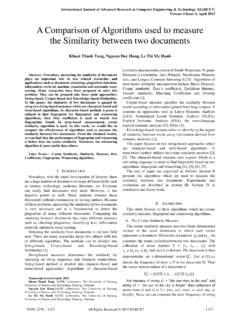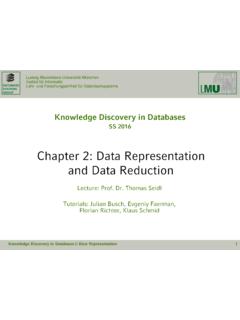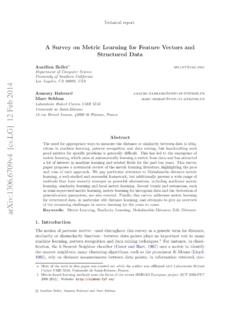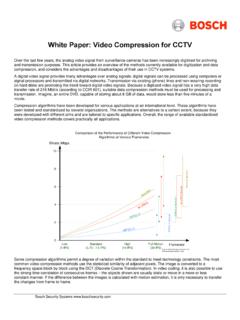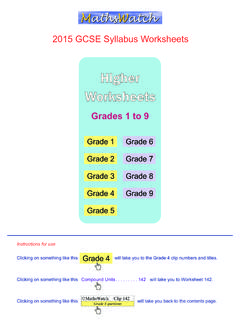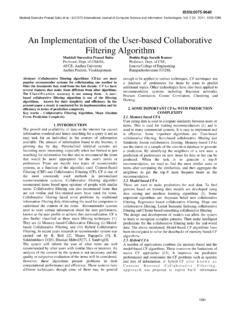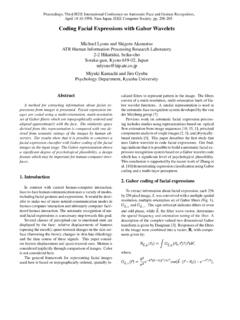Transcription of Practice questions for GCSE Mathematics from 2010
1 OCR 2010 Practice questions for GCSE Mathematics from 2010 GCSE Mathematics A, Mathematics B, Applications of Mathematics and Methods in Mathematics General Certificate of Secondary Education J562, J567, J925, J926 This document consists of past papers for OCR s GCSE Additional Mathematics pilot specification (J915) and may be useful in teaching the new OCR GCSE Mathematics and Linked Pair pilot specifications from September 2010. 2 OCR 2010 Introduction OCR s innovative GCSE Additional Mathematics pilot specification (J915) has proved hugely popular with centres and was fully subscribed with 10 000 learners taking the papers in summer 2008 and 2009.
2 The GCSE Additional Mathematics papers include questions in the style of new Assessment Objective 3, which requires candidates to Interpret and analyse problems and generate strategies to solve them. (AO3 in Methods in Mathematics also includes mathematical reasoning.) GCSE Additional Mathematics is assessed by a single paper covering all grades from G to A*. Each part of a question is designed to build on the previous parts and step up in demand. The intention is that learners of all abilities can attempt at least a part of each question and that the final parts of some questions will provide a suitable challenge for the most able mathematicians. Taken as a whole, these papers therefore have a different style and feel to papers for the new Mathematics and Linked Pair pilot specifications and are not indicative of the style of the new specifications papers.
3 However it is anticipated that teachers will find individual questions interesting and useful classroom resources in preparing students to tackle problem solving questions in Mathematics . The following series of question papers and mark schemes are available. June 2007 January 2008 June 2008 January 2009 June 2009 Please use the PDF bookmarks to navigate to each paper or mark scheme. As pilot centres are still preparing learners for GCSE Additional Mathematics examinations (the specification runs until January 2012) the most recent papers have not been included so that these can continue to be used as mock examinations. However further papers and mark schemes will be added to this booklet in the future.
4 We hope you find this resource useful. GENERAL CERTIFICATE OF SECONDARY EDUCATION J915/01 GCSE LEVEL 1/2 IN ADDITIONAL MATHEMATICSFRIDAY 29 JUNE 2007 MorningTime: 2 hoursCandidates answer on the question materials: Electronic calculator Geometrical instruments Tracing paper (optional)This document consists of 20 printed (KN) T39544/2 OCR 2007 [100/1118/3] OCR is an exempt Charity [Turn overINSTRUCTIONS TO CANDIDATES Write your name, centre number and candidate number in the boxes above. Answer all the questions . Use blue or black ink.]
5 Pencil may be used for graphs and diagrams only. Read each question carefully and make sure you know what you have to do before starting your answer. Show your working. Marks may be given for working that shows that you know how to solve the problem even if you get the answer wrong. You are expected to use an electronic calculator for this paper. Final answers should be rounded to an appropriate degree of accuracy. Do not write in the bar code. Do not write outside the box bordering each page. WRITE YOUR ANSWER TO EACH QUESTION IN THE SPACE PROVIDED. ANSWERS WRITTEN ELSEWHERE WILL NOT BE FOR CANDIDATES The number of marks is given in brackets [ ] at the end of each question or part question.
6 The total number of marks for this paper is 100. Unless otherwise instructed in the question, take to be or use the button on your calculator.*CUP/T39544*For Examiner s Use2 OCR 2007 Formulae Sheetlength Volume of prism = (area of cross-section) x length h l r r cross- section = 1 3 Volume of cone = Curved surface area of cone r 2h r 2 r l 1 2 1 2 A b a c C B 4 3 Volume of sphere = Surface area of sphere = r 3 4 In any triangle ABC a sin A = b sin B = c sin C a 2 = b 2 +c 2 2bc cos A Area of triangle = ab sin C The Quadratic Equation b (b 2 4ac) 2a x = Sine rule Cosine rule The solutions of ax 2 + bx + c = 0,where a = 0, are given bya h b Area of trapezium= (a + b)h 3[Turn over OCR 20071 (a) Jo has the following nine coins in her 1p 2p 50p 10p 1p 20p 2p 1p (i)]
7 Work out the median. (a)(i) _____p [2] (ii) Write down the range. (ii) _____p [1] (b) Twenty people emptied their pockets and counted the number of coins they had.
8 The frequency table shows the of coinsFrequency537685104152 Work out the mean. (b) _____[3]4 OCR 2007 (c) Peta and Chloe each carried out a survey on the amount of money that students, aged 16, spent during one month. There were 180 students in each survey. Peta drew this pie chart to show her results. 120 andup to 160 80 andup to 120 40 andup to 80 0 andup to 4040 120 110 Chloe drew this cumulative frequency diagram to show her results. 04080120160 Cumulativefrequency020601004080120 Money spent ( )20601001401801401605[Turn over OCR 2007 Find a similarity and a difference in the results of the two surveys. Use calculations to justify your : _____ _____Difference: _____ _____[8]_____6 OCR 20072 NuttyCrunchNuttyCrunchFibreFibre Plus Plus The table shows some nutritional information for 100 g of each of these CrunchFibre (a) In a 100 g serving (i) which cereal supplies more energy, (a)(i) _____[1] (ii) how many more kilojoules (kJ) of energy does it supply?]
9 (ii) _____[2] (b) Nutty Crunch is supplied in 40 g packets, Fibre Plus in 50 g packets. (i) How much sugar (in grams) does a 50 g Fibre Plus packet contain? (b)(i) _____ g [1]7[Turn over OCR 2007 (ii) A 40 g packet of Nutty Crunch contains more sugar than a 50 g packet of Fibre Plus: how much more? Give your answer in grams. (ii) _____ g [3] (iii) A packet of Fibre Plus contains more salt than a packet of Nutty Crunch: how much more? Give your answer in grams. (iii) _____ g [4] (c) 100 g of Nutty Crunch provides 55% of the recommended daily allowance of iron.]
10 100 g of Fibre Plus provides 65% of the recommended daily allowance of iron. Calculate the recommended daily allowance of iron. (c) _____mg [4]_____8 OCR 20073 (a) The diagram shows a car s (i) What is the speed of this car in miles per hour? (a)(i) _____mph [1] (ii) The speed limit is 70 miles per hour. Approximately, what is this in kilometres per hour? (ii) _____ km/h [1] (iii) Convert 250 km/h to miles per hour. (iii) _____mph [2] (b) A car travels a distance of 920 metres in 1 minute. Work out the average speed of the car in kilometres per hour. (b) _____ km/h [3]9[Turn over OCR 2007 (c)r The propeller on a Red Bull racer turns 50 times each second.]










